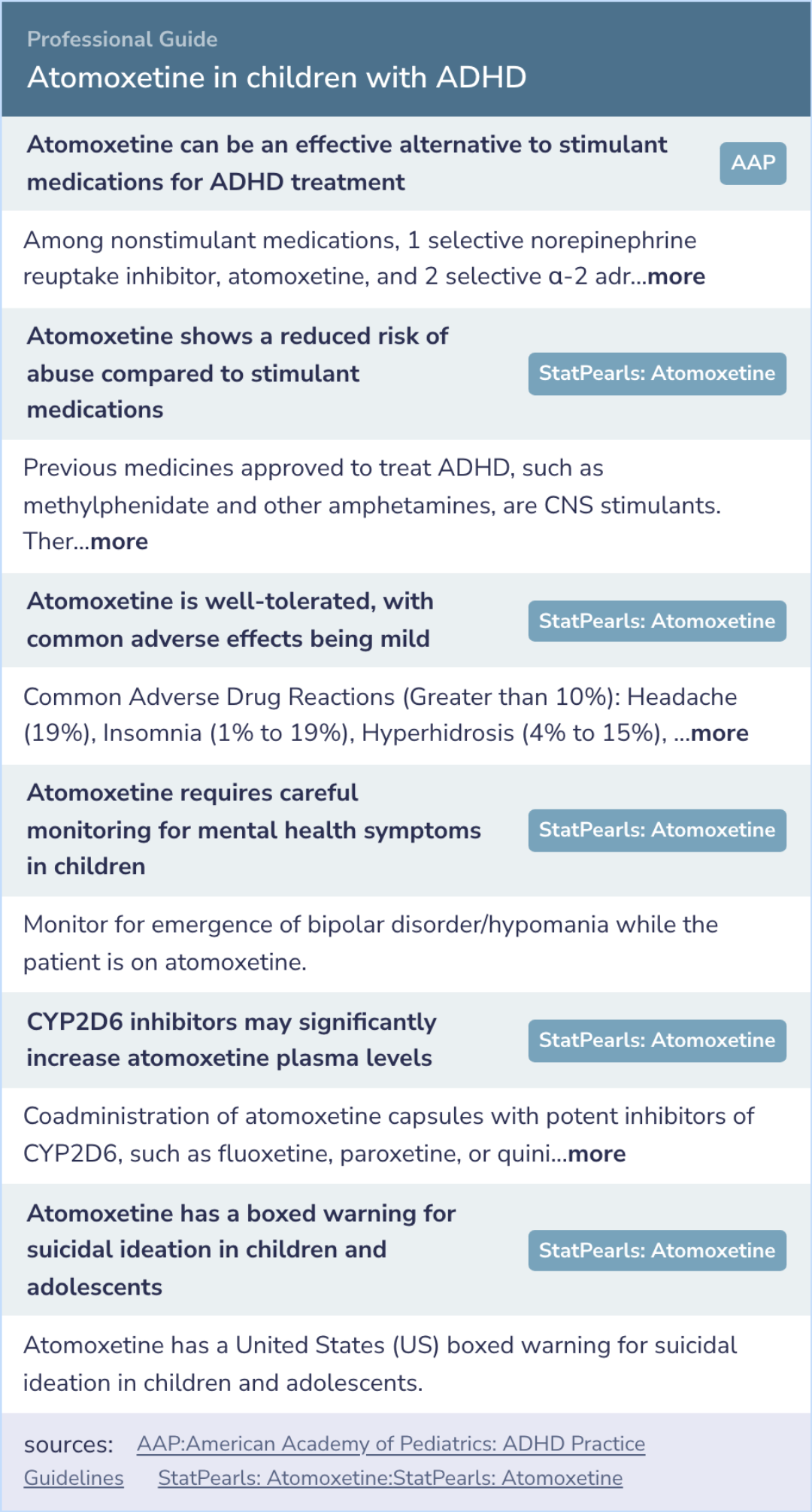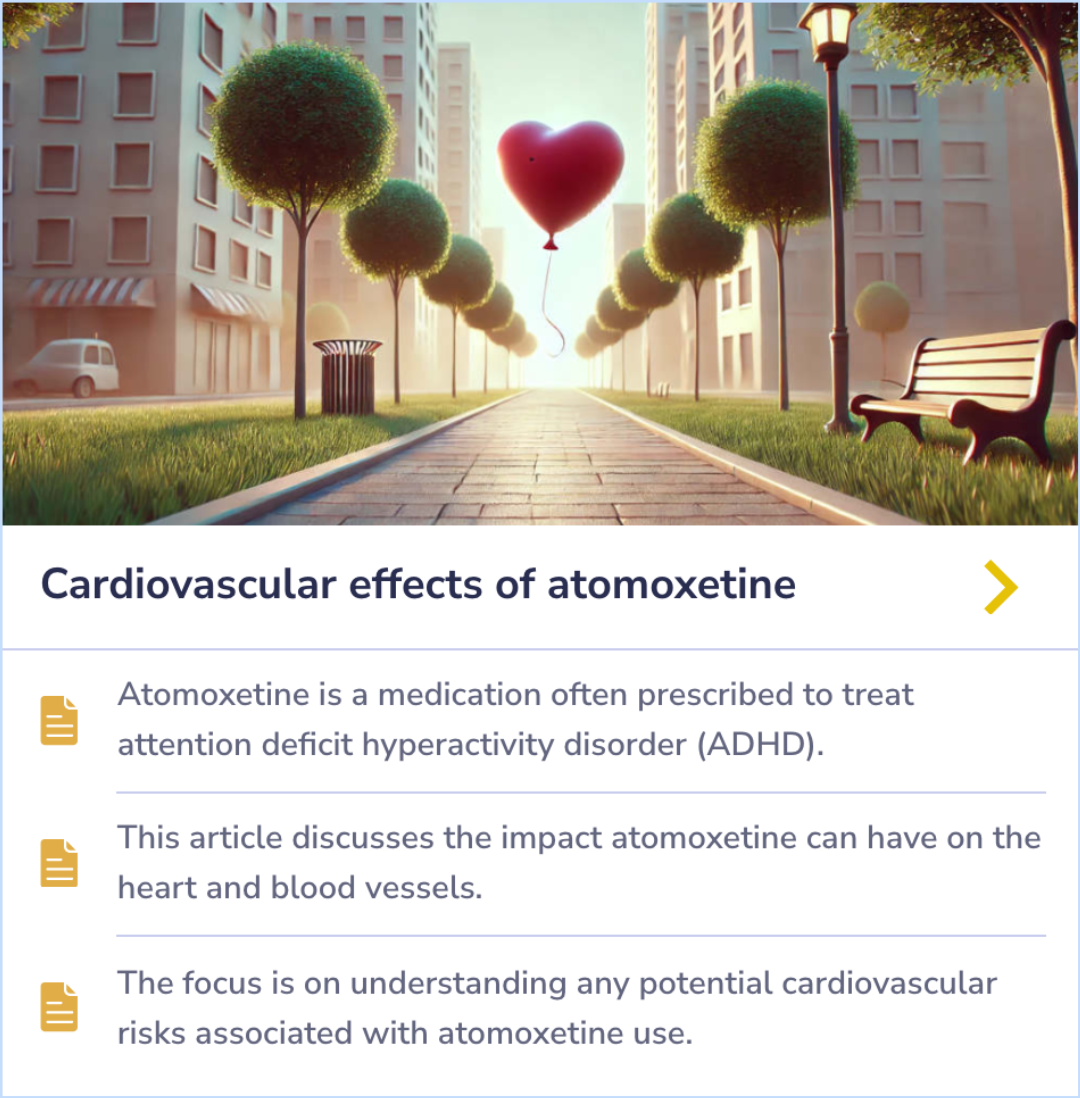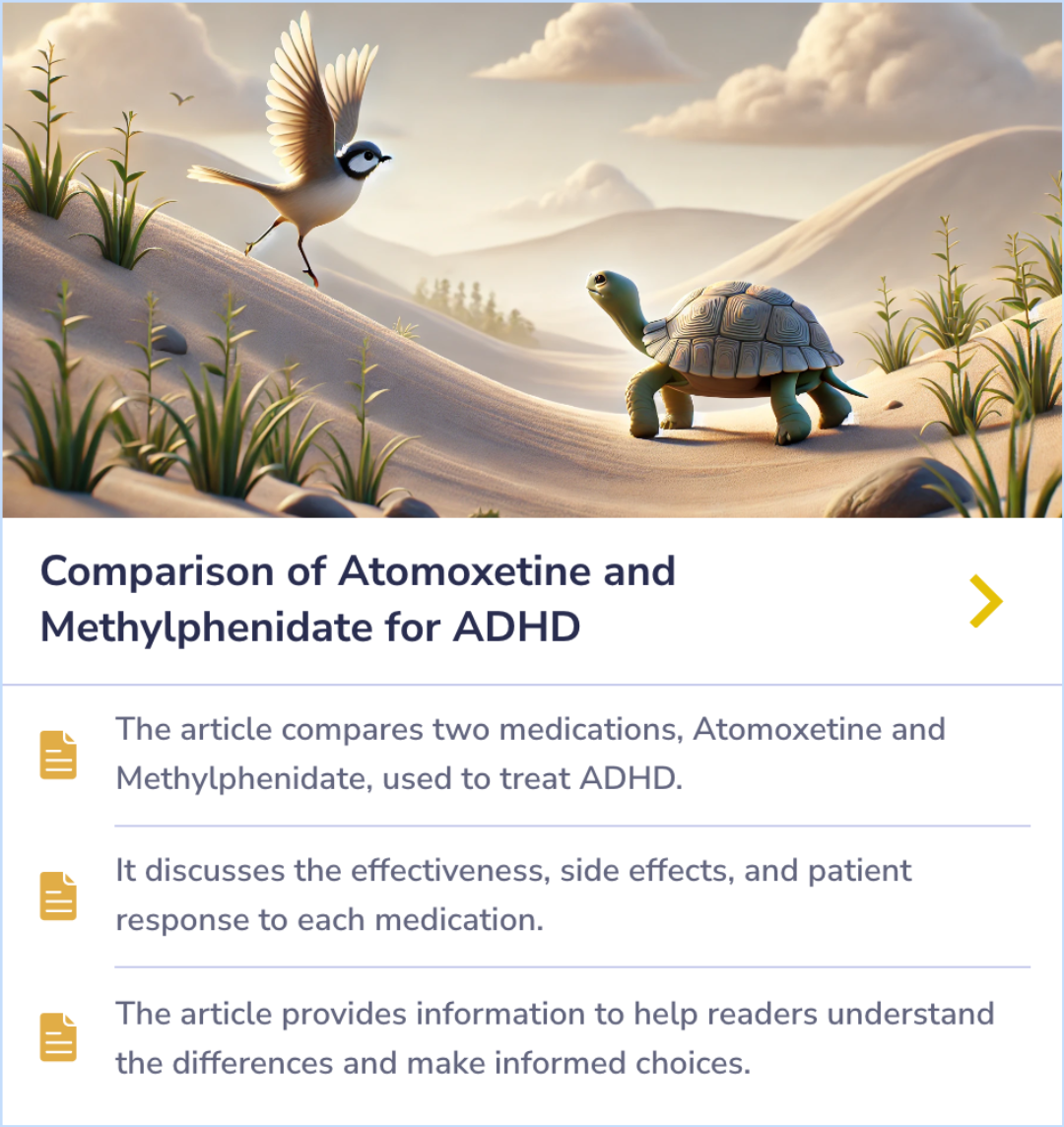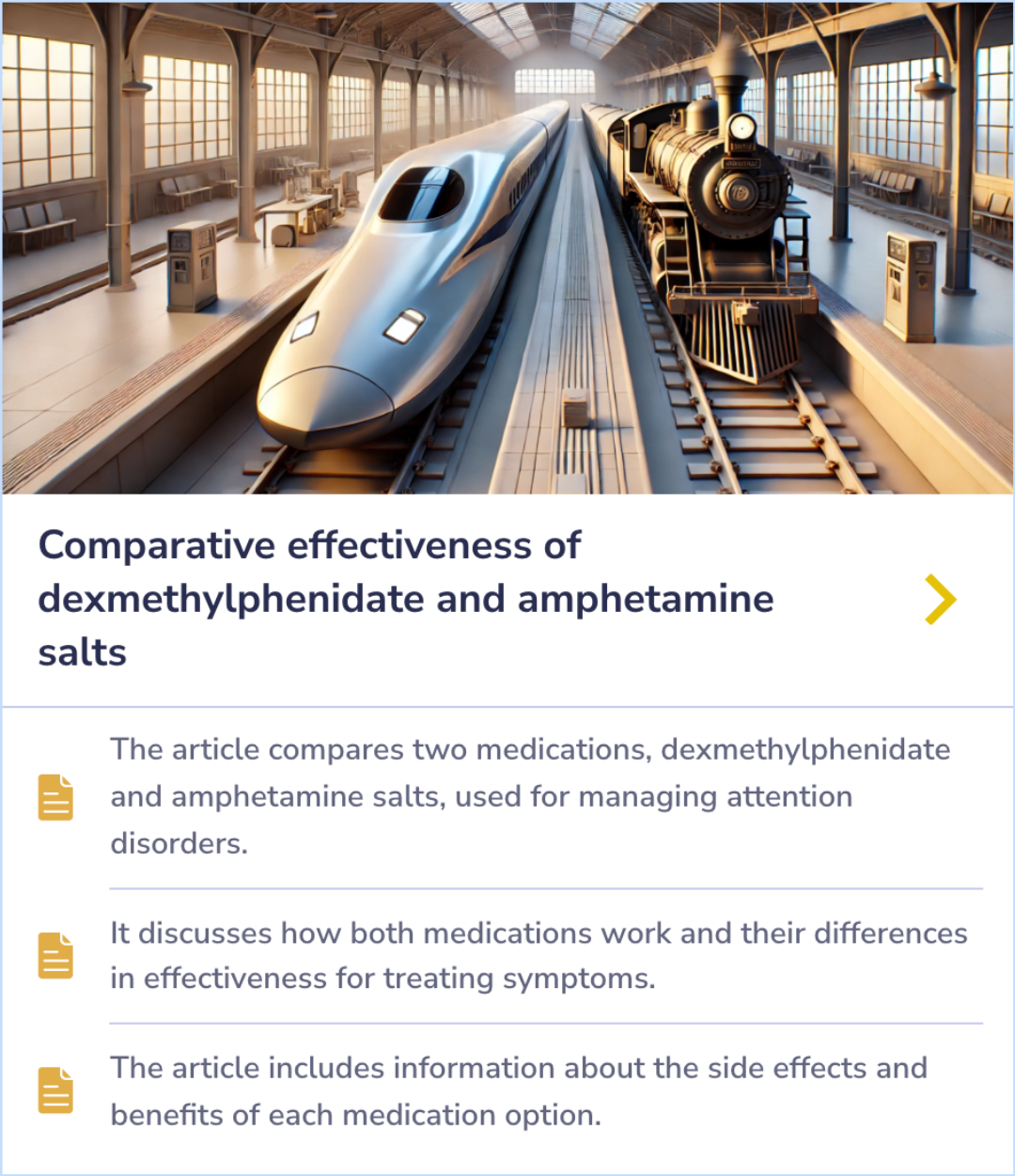Strattera Paper Database
Visual Abstract
An open-label, dose-ranging study of atomoxetine in children with attention deficit hyperactivity disorder
Atomoxetine in children with ADHD
September 14, 2024
author
Spencer T, Biederman J, Heiligenstein J, Wilens T, Faries D, Prince J, Faraone SV, Rea J, Witcher J, Zervas S
journal
J Child Adolesc Psychopharmacol
Date Published
2001 Fall
Why link to a visual abstract?
What is a visual abstract?
Original
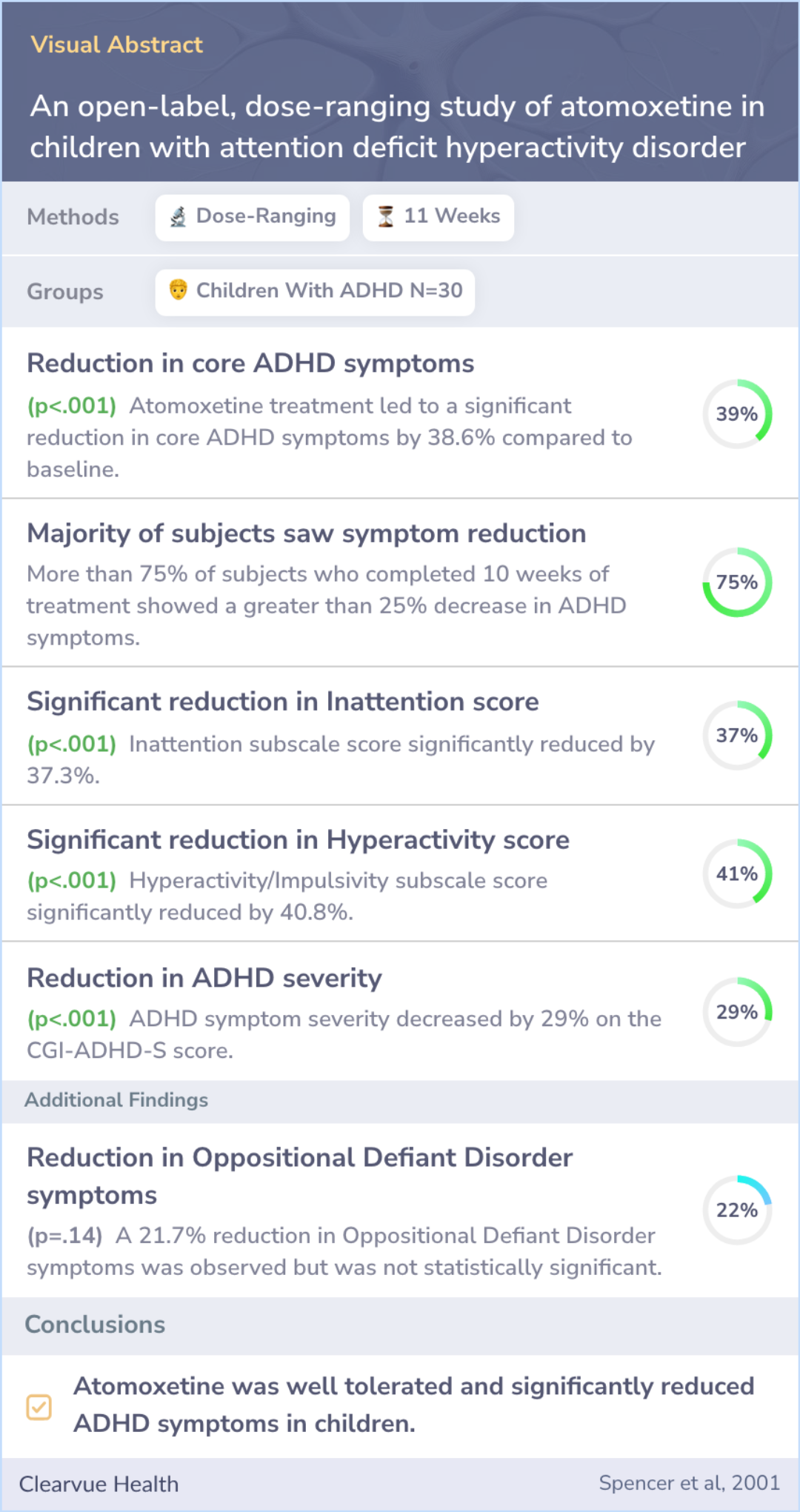
Study Summary
🔬
What They Studied
The study investigated the tolerability and effectiveness of atomoxetine (Strattera) in treating children with ADHD.
💡
What They Found
Atomoxetine (Strattera) was well tolerated and significantly reduced core ADHD symptoms in children.
📚
What This Means
These findings align with previous adult studies on atomoxetine, supporting its use in children and suggesting the need for further controlled trials in pediatric ADHD treatment.
Study Summary
Study Overview
This study aimed to explore the effects of atomoxetine on children with ADHD, building on promising results seen in adults. Researchers hoped to assess how well children tolerate the drug and respond to treatment.
The findings reinforce the value of open-study designs as a step in developing new medications. As atomoxetine shows potential benefits and a low incidence of side effects, it paves the way for future controlled trials and expands treatment options for young patients with ADHD.
The findings reinforce the value of open-study designs as a step in developing new medications. As atomoxetine shows potential benefits and a low incidence of side effects, it paves the way for future controlled trials and expands treatment options for young patients with ADHD.
Abstract: background
The goal of this study was to evaluate the tolerability and effectiveness of the experimental, noradrenergic specific reuptake inhibitor atomoxetine in the treatment of children with attention deficit hyperactivity disorder (ADHD).

Importance of Open-Study Design
"This study illustrates the critical importance as well as the informativeness of the open-study design as a fundamental and strategic step in a rational drug development program."
Support for ADHD Treatment
"These findings extend to children the positive results previously reported in adults diagnosed with ADHD who were treated with atomoxetine."
Therapeutic Potential
"A rational drug development program seeking to extend the evaluation of a novel compound such as atomoxetine to pediatric patients requires initial open-label studies in children to assess efficacy and tolerability."
Study Summary
Methods
In this study, 30 children with ADHD were given atomoxetine, starting from a low dose and increasing to find the most effective and tolerable amount over 11 weeks. Researchers monitored the children closely, observing their behavior and any side effects. Only 22 of the participants completed the entire study, but this was enough for an effective evaluation.
Weekly feedback from parents and clinicians was used to track the children's progress, while their overall health, including heart and lab results, was also monitored.
Weekly feedback from parents and clinicians was used to track the children's progress, while their overall health, including heart and lab results, was also monitored.
Abstract: methods
This was an open, prospective, dose-ranging study of atomoxetine monotherapy in the treatment of 30 children with ADHD between the ages of 7 and 14 years. Atomoxetine was started at 10-20 mg/day and titrated weekly up to 90 mg over 11 weeks, dependin...more

Study Summary
Results
Atomoxetine treatment was generally well-tolerated among the children without significant side effects. It effectively reduced ADHD symptoms, showing an overall decrease of nearly 40% in core ADHD symptoms, according to specific rating scales. Most children who completed the study experienced considerable improvement.
An impressive three-quarters of participants who stayed for the 10-week study saw over a 25% reduction in symptoms, suggesting the treatment's effectiveness and potential as a reliable option.
An impressive three-quarters of participants who stayed for the 10-week study saw over a 25% reduction in symptoms, suggesting the treatment's effectiveness and potential as a reliable option.
Abstract: results
Treatment with atomoxetine (mean final, total daily dose of 1.9 mg/kg/day) was very well tolerated without meaningful adverse effects. Atomoxetine significantly reduced core symptoms of ADHD (ADHD-Rating Scale-IV; 38.6% decrease vs. baseline, p < 0.0...more
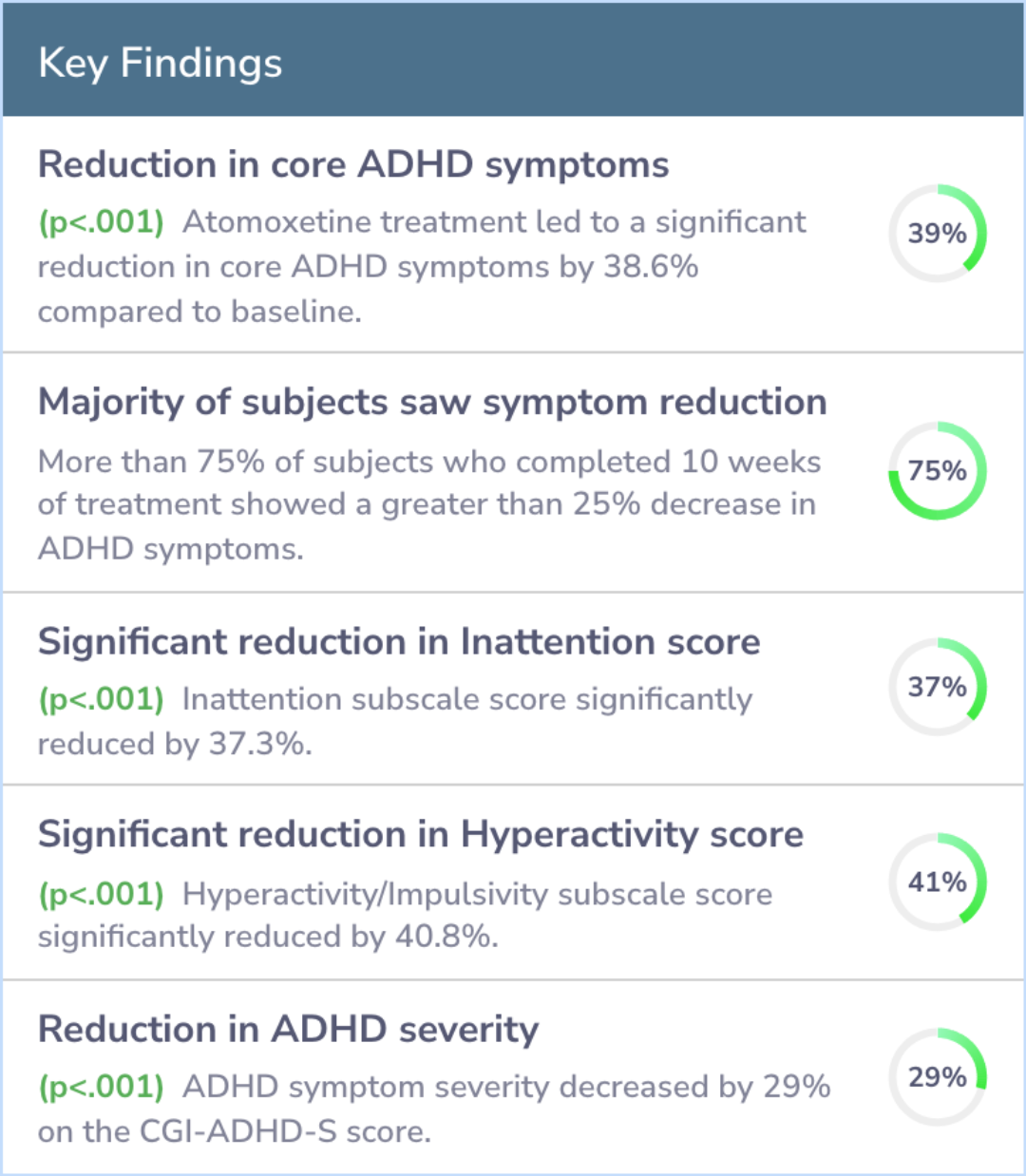
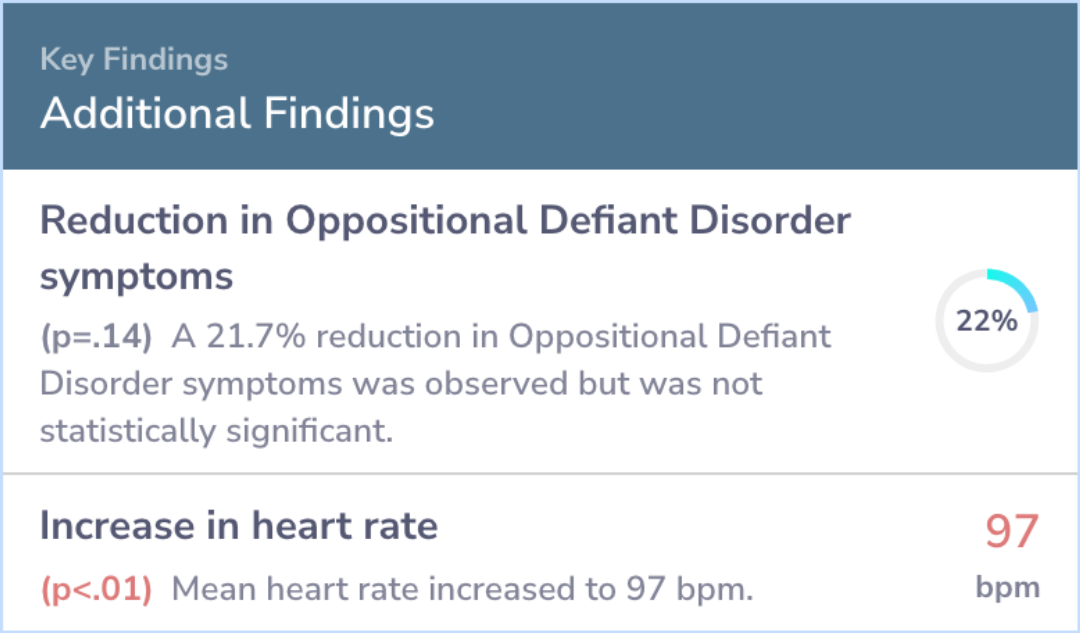
Study Summary
Conclusions
The results suggest that atomoxetine can effectively alleviate ADHD symptoms in children, mirroring past positive findings in adults. This promising outcome supports conducting further detailed studies with controlled environments to confirm these effects in kids.
This study opens the door to additional research to solidify atomoxetine's place in treating pediatric ADHD, highlighting its potential as a beneficial therapy.
This study opens the door to additional research to solidify atomoxetine's place in treating pediatric ADHD, highlighting its potential as a beneficial therapy.
Abstract: conclusions
These findings extend to children the positive results previously reported in adults diagnosed with ADHD who were treated with atomoxetine. These results support additional controlled trials of atomoxetine in cases of pediatric ADHD.
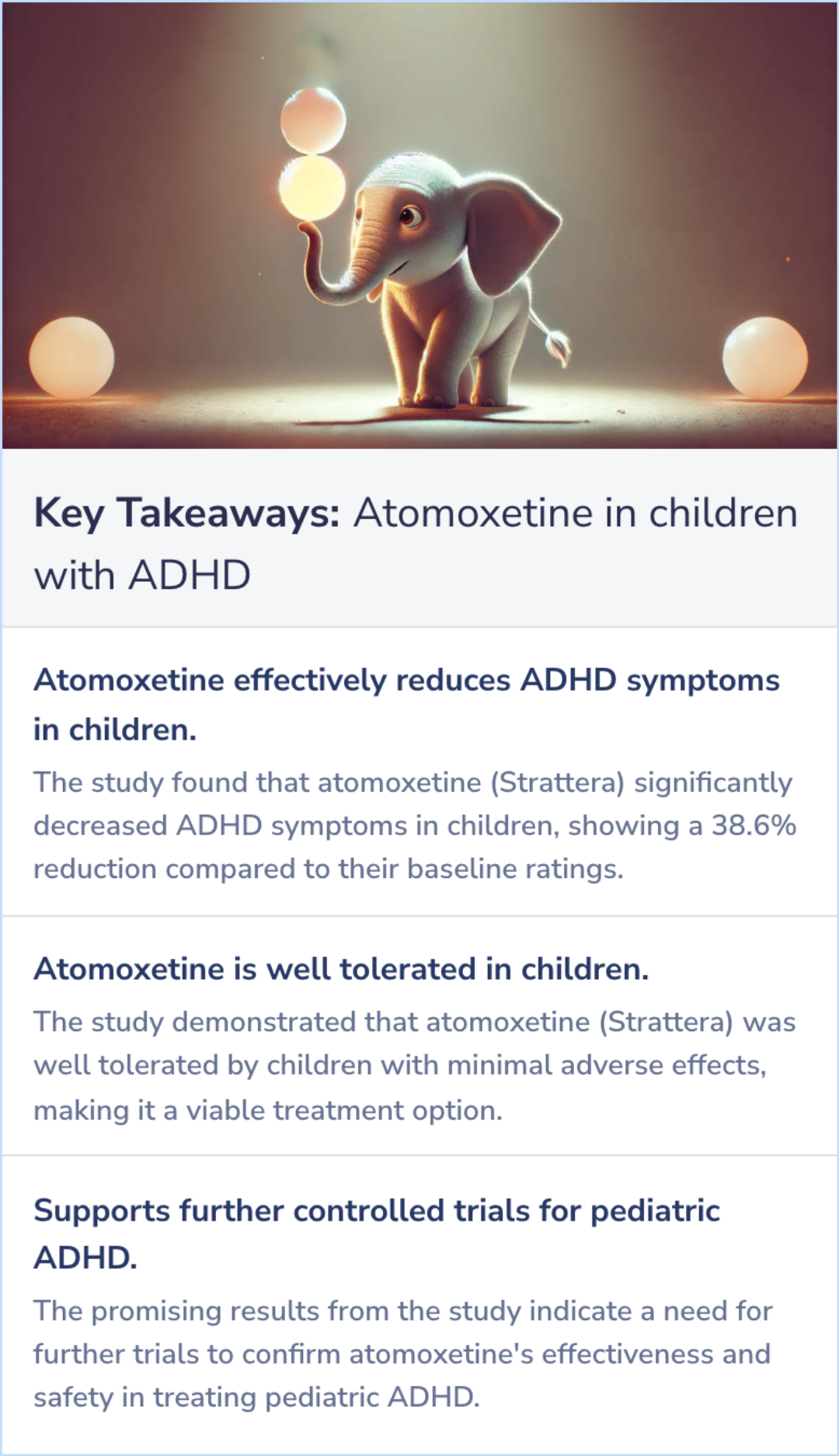
Background Information
Patient Guide
💊
FDA Approval for ADHD
Strattera is approved to treat ADHD in adults and children over six, highlighting its relevance for pediatric care.
⚙️
Atomoxetine Mechanism
As a selective norepinephrine reuptake inhibitor, atomoxetine uniquely targets ADHD symptoms in children.
🔢
Dosing Adaptations
Children's dosing of atomoxetine adjusts based on weight, starting at lower mg levels, supporting dose-ranging study design.
🤕
Common Adverse Effects
Common side effects of atomoxetine include headaches and appetite changes, necessitating monitoring during treatment trials.
🧠
Comprehensive ADHD Program
Atomoxetine is part of broader ADHD treatment, integrating psychological and educational interventions.
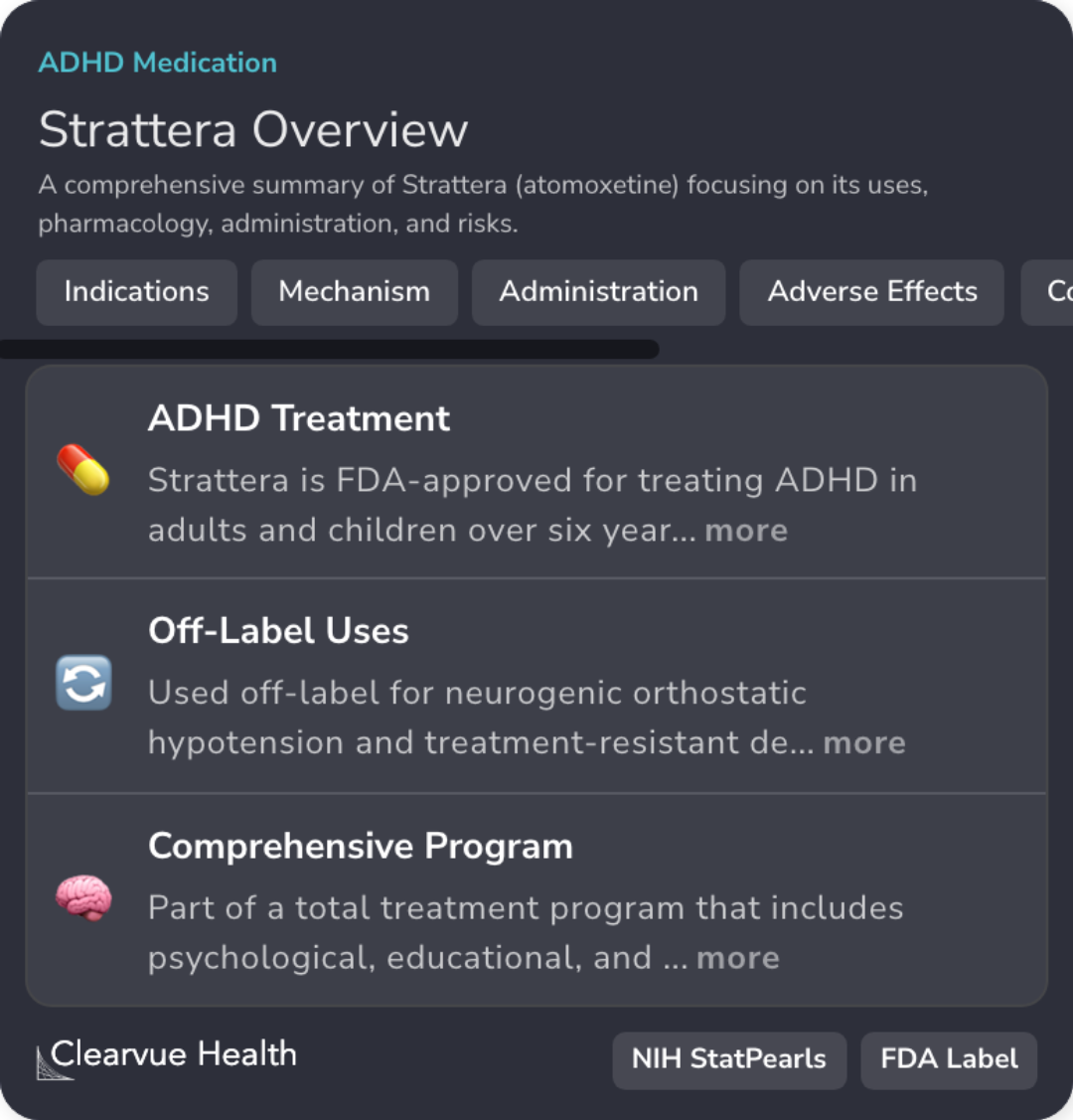
Professional Guide
Expert Opinion: Atomoxetine in children with ADHD
The findings suggest atomoxetine is a viable alternative treatment for pediatric ADHD with its robust efficacy.
Notably, it presents a reduced risk of abuse compared to traditional stimulants, addressing a significant concern in ADHD treatment.
While generally well-tolerated, clinicians should remain vigilant about common mild adverse effects and monitor growth in children.
Monitoring is crucial for mitigating risks such as dose adjustments for CYP2D6 poor metabolizers and potential mental health concerns.
Notably, it presents a reduced risk of abuse compared to traditional stimulants, addressing a significant concern in ADHD treatment.
While generally well-tolerated, clinicians should remain vigilant about common mild adverse effects and monitor growth in children.
Monitoring is crucial for mitigating risks such as dose adjustments for CYP2D6 poor metabolizers and potential mental health concerns.
Evidence Summary
Exploring Atomoxetine’s Cardiovascular Impact
Atomoxetine, commonly used to treat ADHD, can also affect the heart and blood vessels. The content highlights possible cardiovascular risks linked to its use. While its impact on ADHD symptoms is well-documented, this piece shifts the focus to potential side effects involving the cardiovascular system.
The examination centers on the medication’s effects on the heart and circulatory system, bringing attention to any risks that may accompany its use in treating ADHD.
The examination centers on the medication’s effects on the heart and circulatory system, bringing attention to any risks that may accompany its use in treating ADHD.
Evidence Summary
Understanding Key Differences Between Atomoxetine and Methylphenidate
Comparing Atomoxetine and Methylphenidate reveals their differences in treating ADHD. Both medications are widely used, but they have distinct effects on patients, including their effectiveness and side effects. Understanding these differences can guide treatment choices.
This comparison helps in making informed decisions by highlighting how patients respond differently to each medication.
This comparison helps in making informed decisions by highlighting how patients respond differently to each medication.
Evidence Summary
Comparing Dexmethylphenidate and Amphetamine Salts
This card breaks down the differences between dexmethylphenidate and amphetamine salts, two medications used to manage attention disorders. It explains how each medication works, their benefits, and potential side effects, giving you a clear comparison between the two options.
You’ll find insights into their effectiveness for treating symptoms, helping to highlight how these medications differ in managing attention disorders.
You’ll find insights into their effectiveness for treating symptoms, helping to highlight how these medications differ in managing attention disorders.
